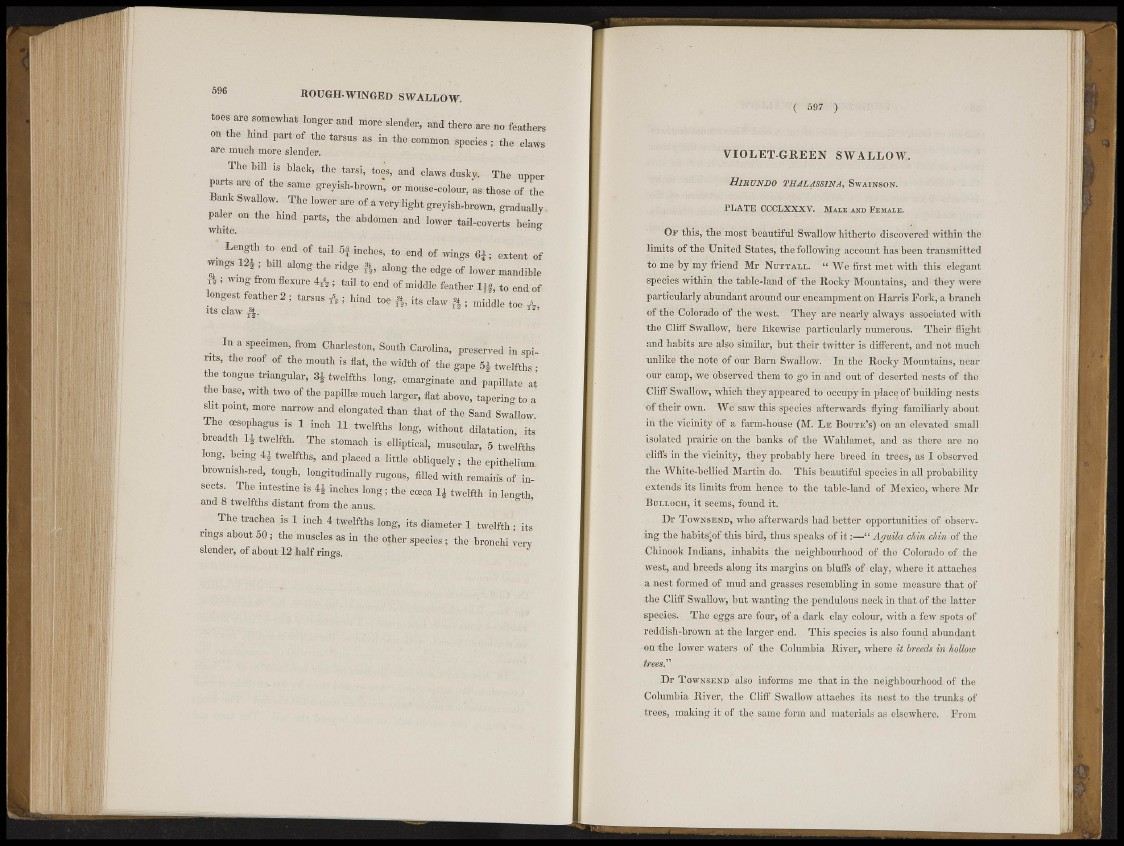
m ROUGH-WINGED. SWALLOW.
B E SOMe^ i o M g e i ; and more slender, and there are u o f e a l hm.
0 B '.f* p a r t 0f ^ to common « s ; the elaws
are much more slender.
The bill is black, the tarsi, tog, and claws duskv, H H
rtrn I • ^ B B • • • • • •
Bank Swallow. The loWOT a.e vorvl! shtgrensh-br o r a , gradually.
H H | H «o m e n and lower H M
; Length to end ssif tail 5f inches, to, end of w i n g s e s t e n t of
W| ; W a f c n g the ridge, ft, along the edge of lower mandible
; &omflemre 4 A , tail to ,,,,1 of middle feather l}f, to end of
longest feather 2 ; tarsus A ; hind toe«, its claw ; middle to^
Jts claw h •. . -*-"'-'" jMBM" ' ' '•-"'••• j g r '
•• In a specimen, from Charleston, South Carolina, pressed' inspirits,
the roof of the month is Hat, , he width of the gape S* twelfthsfte
tongue triangular, 3§ twelfths long, emarginate and papiljate at
the b;use, wth two of the pnpill» ,„,u:h larger, flat above, tapering to a
sht l>omt more narrow and e l tagaj # than: that of the,.Sand Swallow
The esophagus in I inch 11 twelfths'tpng, without M H H
breadth li,twelfth. The .stomach .is elliptical, muscular, 5 twelfths
longfcbejpg 4. twelfths, aad placed a httle, obhquely, the epithelium
brownish-red, tough, longitudinally rugous, filled with remains of i„.
sects. The intestine'is ^ inches lohg5 the cceca 1 | twelfth in length
and 8. twelfths distant from the «aims.
The trachea is 1 inch 4 twelfths long, its diameter 1 twelfth • i t s " '
rings about 50; the muscles as in the other species; the bronchi very
slender, of about 12 half rings. ".-rUi*..
( )
V I O L E T - G R E E N SWALLOW.
HlRUNDO TBALASS1NA, SwAINSON.
PLATO CCCLXXXV. Male AND Femaxe.
Of this, the most beautiful Swallow hitherto discovered within the
limits of the United States, the following account has been transmitted
to me by my friend Mr Nutta®;®*' " We first met with this elegant
specics within the table-land of the Rocky Mountains; and they were
particularly abundant around our encampment on Harris Fork, a branch
of the Colorado of the west. They are nearly always associated with
the Cliff Swallow, here likewise particularly numerous. Their flight
and habits are also Similar, but their twitter is different, and not much
Tinlike the note of our Barn Swallow. In the Rocky Mountains, near
our camp, we observed theih to go in and out of deserted nests of the
Cliff Swallow, which they appeared fe'oecupy in place of building nests
of their own. We saw this species afterwards flying familiarly about
in the vicinity of a farm-house (M. Le Boote's) on an elevated small
isolated prairie on the banks of the Walilamet, :and as there are no
c t t s in the vicinity, they probably here breed in trees, as I observed
the White-belled Martin do. This beautiful species in all probability
extends its limits from hence to the table-land of Mexico, where Mr
Bnt.i.ocii, it seems, found it.
Dr Towssend, who afterwards had better opportunities of observing
the habits:of this bird, thus speaks of i t :—" AgmlacMu chin of the
Chinook Indians, inhabits the neighbourhood of the Colorado of the
west, and breeds alone its margins on bluffs of clay, where it attaches
a nest formed of mud and grasses resembling in some measure that of
the .Cliff Swallow, but wanting the pendulous neck in that of the latter
species. The eggs are four, of a dark clay colour, with a few spots of
reddish-brown at the larger end. This species is also found abundant
on the lower waters of the Columbia River,, where it breeds m hollow
trees"
Dr TrOWNsEjiD also informs me that in the neighbourhood of the
Columbia River, the Cliff Swallow attaches its nest to the trunks of
trees, making it of the same form and materials as elsewhere. From